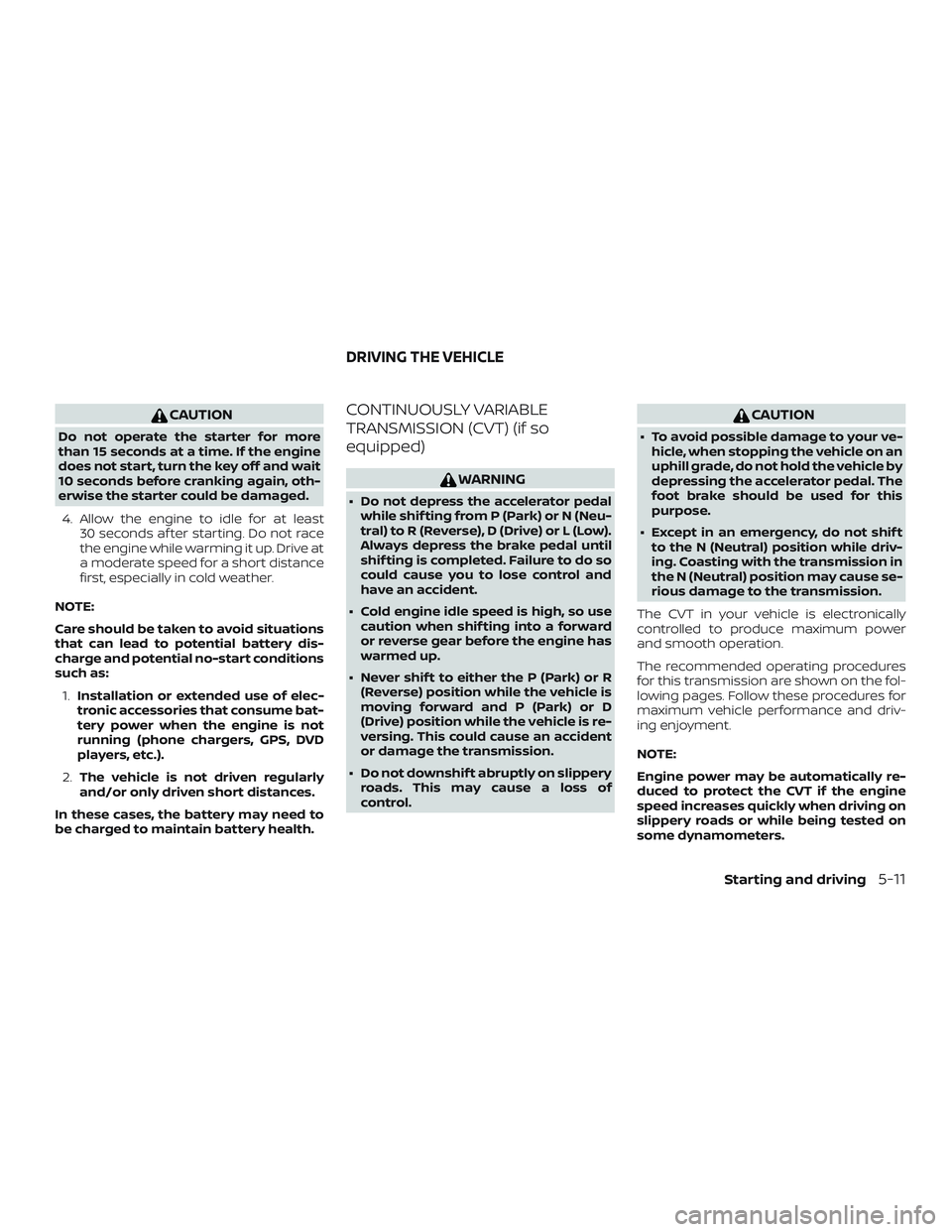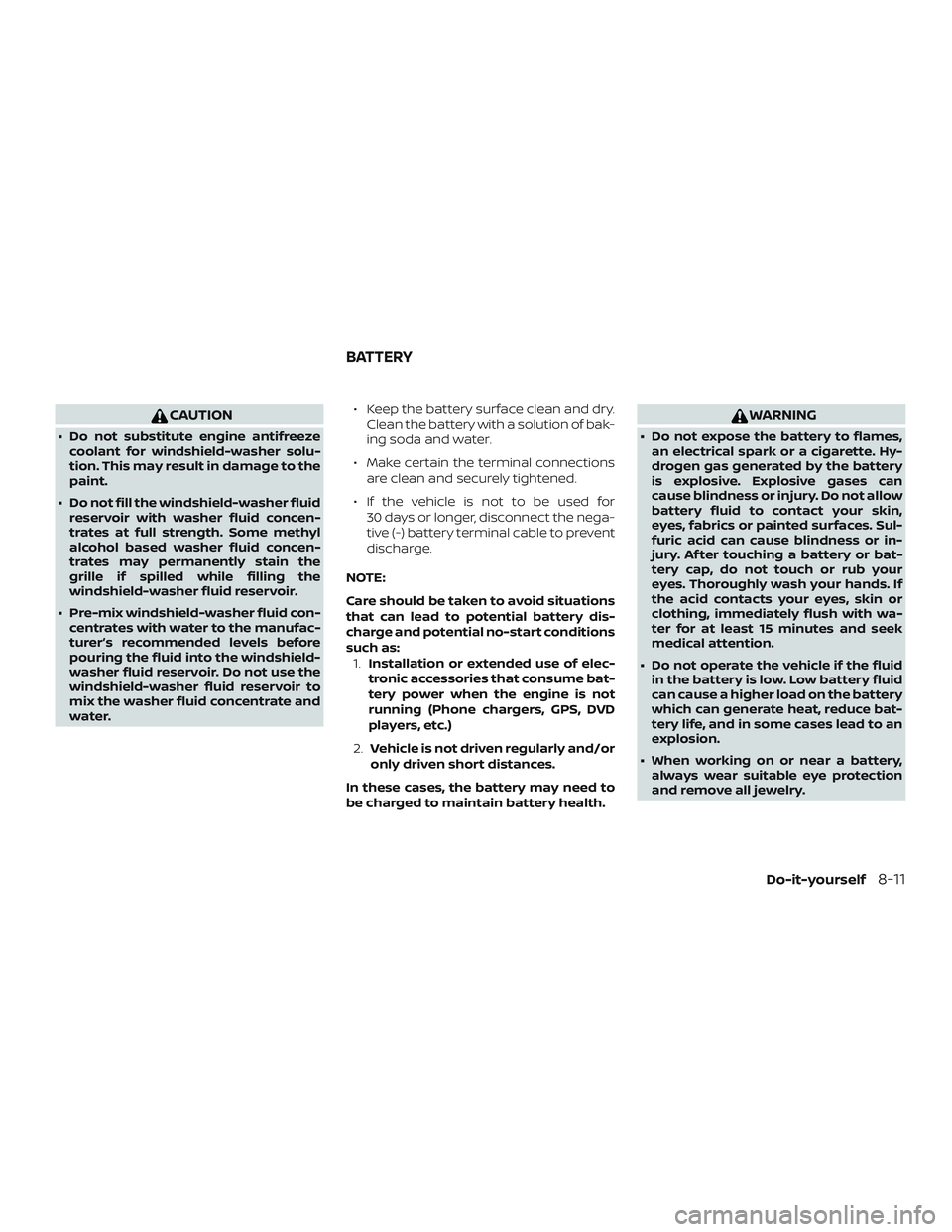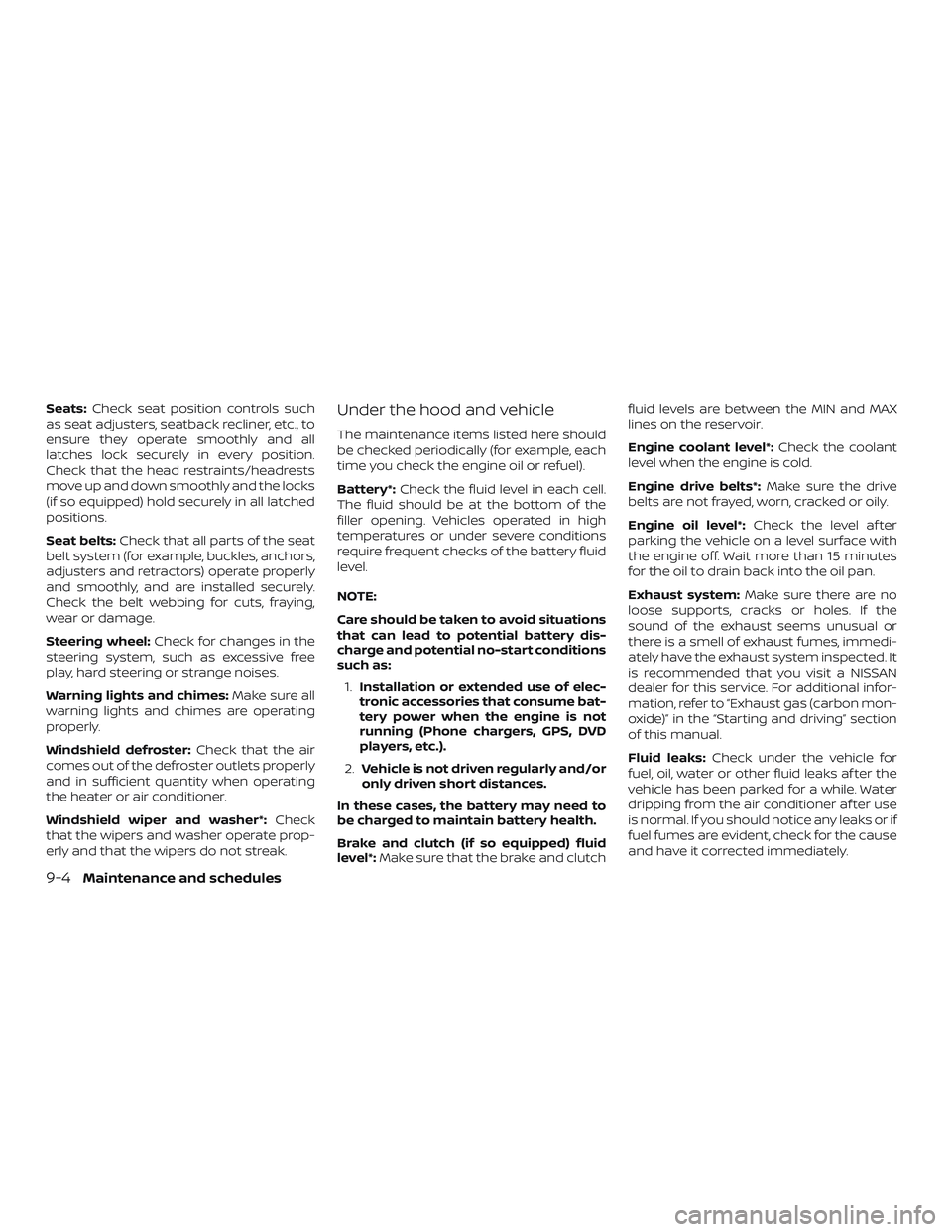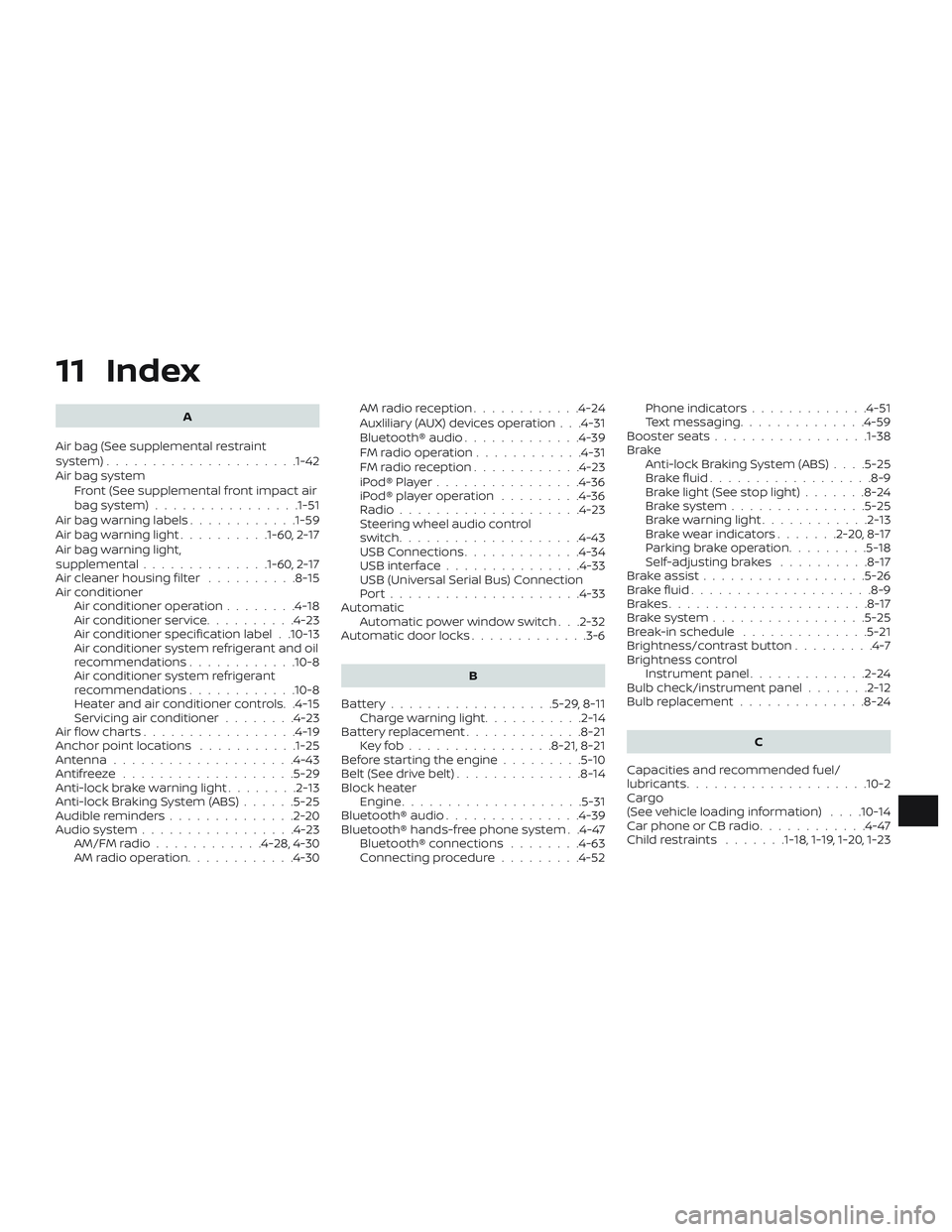2018 NISSAN VERSA SEDAN CD player
[x] Cancel search: CD playerPage 565 of 702

CAUTION
Do not operate the starter for more
than 15 seconds at a time. If the engine
does not start, turn the key off and wait
10 seconds before cranking again, oth-
erwise the starter could be damaged.4. Allow the engine to idle for at least 30 seconds af ter starting. Do not race
the engine while warming it up. Drive at
a moderate speed for a short distance
first, especially in cold weather.
NOTE:
Care should be taken to avoid situations
that can lead to potential battery dis-
charge and potential no-start conditions
such as: 1. Installation or extended use of elec-
tronic accessories that consume bat-
tery power when the engine is not
running (phone chargers, GPS, DVD
players, etc.).
2. The vehicle is not driven regularly
and/or only driven short distances.
In these cases, the battery may need to
be charged to maintain battery health.
CONTINUOUSLY VARIABLE
TRANSMISSION (CVT) (if so
equipped)
WARNING
∙ Do not depress the accelerator pedal while shif ting from P (Park) or N (Neu-
tral) to R (Reverse), D (Drive) or L (Low).
Always depress the brake pedal until
shif ting is completed. Failure to do so
could cause you to lose control and
have an accident.
∙ Cold engine idle speed is high, so use caution when shif ting into a forward
or reverse gear before the engine has
warmed up.
∙ Never shif t to either the P (Park) or R (Reverse) position while the vehicle is
moving forward and P (Park) or D
(Drive) position while the vehicle is re-
versing. This could cause an accident
or damage the transmission.
∙ Do not downshif t abruptly on slippery roads. This may cause a loss of
control.
CAUTION
∙ To avoid possible damage to your ve-hicle, when stopping the vehicle on an
uphill grade, do not hold the vehicle by
depressing the accelerator pedal. The
foot brake should be used for this
purpose.
∙ Except in an emergency, do not shif t to the N (Neutral) position while driv-
ing. Coasting with the transmission in
the N (Neutral) position may cause se-
rious damage to the transmission.
The CVT in your vehicle is electronically
controlled to produce maximum power
and smooth operation.
The recommended operating procedures
for this transmission are shown on the fol-
lowing pages. Follow these procedures for
maximum vehicle performance and driv-
ing enjoyment.
NOTE:
Engine power may be automatically re-
duced to protect the CVT if the engine
speed increases quickly when driving on
slippery roads or while being tested on
some dynamometers.
DRIVING THE VEHICLE
Starting and driving5-11
Page 621 of 702

CAUTION
∙ Do not substitute engine antifreezecoolant for windshield-washer solu-
tion. This may result in damage to the
paint.
∙ Do not fill the windshield-washer fluid reservoir with washer fluid concen-
trates at full strength. Some methyl
alcohol based washer fluid concen-
trates may permanently stain the
grille if spilled while filling the
windshield-washer fluid reservoir.
∙ Pre-mix windshield-washer fluid con- centrates with water to the manufac-
turer’s recommended levels before
pouring the fluid into the windshield-
washer fluid reservoir. Do not use the
windshield-washer fluid reservoir to
mix the washer fluid concentrate and
water. ∙ Keep the battery surface clean and dry.
Clean the battery with a solution of bak-
ing soda and water.
∙ Make certain the terminal connections are clean and securely tightened.
∙ If the vehicle is not to be used for 30 days or longer, disconnect the nega-
tive (-) battery terminal cable to prevent
discharge.
NOTE:
Care should be taken to avoid situations
that can lead to potential battery dis-
charge and potential no-start conditions
such as: 1. Installation or extended use of elec-
tronic accessories that consume bat-
tery power when the engine is not
running (Phone chargers, GPS, DVD
players, etc.)
2. Vehicle is not driven regularly and/or
only driven short distances.
In these cases, the battery may need to
be charged to maintain battery health.
WARNING
∙ Do not expose the battery to flames, an electrical spark or a cigarette. Hy-
drogen gas generated by the battery
is explosive. Explosive gases can
cause blindness or injury. Do not allow
battery fluid to contact your skin,
eyes, fabrics or painted surfaces. Sul-
furic acid can cause blindness or in-
jury. Af ter touching a battery or bat-
tery cap, do not touch or rub your
eyes. Thoroughly wash your hands. If
the acid contacts your eyes, skin or
clothing, immediately flush with wa-
ter for at least 15 minutes and seek
medical attention.
∙ Do not operate the vehicle if the fluid in the battery is low. Low battery fluid
can cause a higher load on the battery
which can generate heat, reduce bat-
tery life, and in some cases lead to an
explosion.
∙ When working on or near a battery, always wear suitable eye protection
and remove all jewelry.
BATTERY
Do-it-yourself8-11
Page 654 of 702

Seats:Check seat position controls such
as seat adjusters, seatback recliner, etc., to
ensure they operate smoothly and all
latches lock securely in every position.
Check that the head restraints/headrests
move up and down smoothly and the locks
(if so equipped) hold securely in all latched
positions.
Seat belts: Check that all parts of the seat
belt system (for example, buckles, anchors,
adjusters and retractors) operate properly
and smoothly, and are installed securely.
Check the belt webbing for cuts, fraying,
wear or damage.
Steering wheel: Check for changes in the
steering system, such as excessive free
play, hard steering or strange noises.
Warning lights and chimes: Make sure all
warning lights and chimes are operating
properly.
Windshield defroster: Check that the air
comes out of the defroster outlets properly
and in sufficient quantity when operating
the heater or air conditioner.
Windshield wiper and washer*: Check
that the wipers and washer operate prop-
erly and that the wipers do not streak.Under the hood and vehicle
The maintenance items listed here should
be checked periodically (for example, each
time you check the engine oil or refuel).
Battery*: Check the fluid level in each cell.
The fluid should be at the bottom of the
filler opening. Vehicles operated in high
temperatures or under severe conditions
require frequent checks of the battery fluid
level.
NOTE:
Care should be taken to avoid situations
that can lead to potential battery dis-
charge and potential no-start conditions
such as:
1. Installation or extended use of elec-
tronic accessories that consume bat-
tery power when the engine is not
running (Phone chargers, GPS, DVD
players, etc.).
2. Vehicle is not driven regularly and/or
only driven short distances.
In these cases, the battery may need to
be charged to maintain battery health.
Brake and clutch (if so equipped) fluid
level*: Make sure that the brake and clutch fluid levels are between the MIN and MAX
lines on the reservoir.
Engine coolant level*:
Check the coolant
level when the engine is cold.
Engine drive belts*: Make sure the drive
belts are not frayed, worn, cracked or oily.
Engine oil level*: Check the level af ter
parking the vehicle on a level surface with
the engine off. Wait more than 15 minutes
for the oil to drain back into the oil pan.
Exhaust system: Make sure there are no
loose supports, cracks or holes. If the
sound of the exhaust seems unusual or
there is a smell of exhaust fumes, immedi-
ately have the exhaust system inspected. It
is recommended that you visit a NISSAN
dealer for this service. For additional infor-
mation, refer to “Exhaust gas (carbon mon-
oxide)” in the “Starting and driving” section
of this manual.
Fluid leaks: Check under the vehicle for
fuel, oil, water or other fluid leaks af ter the
vehicle has been parked for a while. Water
dripping from the air conditioner af ter use
is normal. If you should notice any leaks or if
fuel fumes are evident, check for the cause
and have it corrected immediately.
9-4Maintenance and schedules
Page 689 of 702

11 Index
A
Air bag (See supplemental restraint
system) .................... .1-42
Air bag system Front (See supplemental front impact air
bagsystem)................1-51
Air bag warning labels ............1-59
Airbagwarninglight..........1-60, 2-17
Air bag warning light,
supplemental ..............1-60, 2-17
Air cleaner housing filter ..........8-15
Air conditioner Air conditioner operation ........4-18
Air conditioner service ..........4-23
Air conditioner specification label . .10-13
Air conditioner system refrigerant and oil
recommendations ............10-8
Air conditioner system refrigerant
recommendations ............10-8
Heater and air conditioner controls. .4-15
Servicing air conditioner ........4-23
Air flow charts .................4-19
Anchor point locations ...........1-25
Antenna ....................4-43
Antifreeze ...................5-29
Anti-lock brake warning light ........2-13
Anti-lock Braking System (ABS) ......5-25
Audible reminders ..............2-20
Audio system .................4-23
AM/FMradio............4-28,4-30
AM radio operation ............4-30 AMradioreception............4-24
Auxliliary (AUX) devices operation . . .4-31
Bluetooth® audio
.............4-39
FM radio operation ............4-31
FMradioreception............4-23
iPod®Player................4-36
iPod® player operation .........4-36
Radio ....................4-23
Steering wheel audio control
switch....................4-43
USB Connections .............4-34
USBinterface...............4-33
USB (Universal Serial Bus) Connection
Port.....................4-33
Automatic Automatic power window switch . . .2-32
Automatic door locks .............3-6
B
Battery..................5-29,8-11 Charge warning light ...........2-14
Battery replacement .............8-21
Keyfob................8-21,8-21
Before starting the engine .........5-10
Belt(Seedrivebelt)..............8-14
Block heater Engine ....................5-31
Bluetooth® audio ...............4-39
Bluetooth® hands-free phone system . .4-47 Bluetooth® connections ........4-63
Connecting procedure .........4-52 Phone indicators
.............4-51
Text messaging ..............4-59
Booster seats .................1-38
Brake Anti-lock Braking System (ABS) ....5-25
Brakefluid..................8-9
Brakelight(Seestoplight).......8-24
Brakesystem...............5-25
Brakewarninglight............2-13
Brakewearindicators.......2-20,8-17
Parking brake operation .........5-18
Self-adjustingbrakes ..........8-17
Brakeassist..................5-26
Brakefluid....................8-9
Brakes......................8-17
Brakesystem.................5-25
Break-in schedule ..............5-21
Brightness/contrast button .........4-7
Brightness control Instrument
panel.............2-24
Bulb check/instrument panel .......2-12
Bulb replacement ..............8-24
C
Capacities and recommended fuel/
lubricants....................10-2
Cargo
(See vehicle loading information) . . . .10-14
Car phone or CB radio ............4-47
Childrestraints .......1-18, 1-19, 1-20, 1-23
Page 691 of 702

Engine oil...................8-6
F.M.V.S.S. certification label .........10-12
Foglightswitch................2-25
Front air bag system
(See supplemental restraint system) . . . .1-51
Front-door pocket ...............2-27
Frontseats................... .1-2
Fuel Capacities and recommended
fuel/lubricants...............10-2
Fuel economy ...............5-22
Fuel-filler cap ................3-14
Fuel-filler door lock opener lever ....3-14
Fuel-filler lid .................3-14
Fuel gauge ..................2-9
Fueloctanerating.............10-6
Fuel recommendation ..........10-4
Loose fuel cap warning ..........2-7
Fuelefficientdrivingtips...........5-21
Fuel-filler door .................3-14
Fuel gauge ....................2-9
Fuses .......................8-18
Fusiblelinks...................8-18
G
Gascap .....................3-14
Gauge Engine coolant temperature gauge . .2-9
Fuel gauge ..................2-9
Odometer ..................2-6
Speedometer ................2-5
Tachometer .................2-8
Trip computer ...............2-10
Trip odometer .............2-5,2-6 General maintenance
.............9-2
Glovebox....................2-29
H
Hands-free phone system, Bluetooth® . .4-47
Hazard warning flasher switch ........6-2
Headlight and turn signal switch ......2-22
Headlightcontrolswitch...........2-22
Headlights ...................8-22
Headrestraints ................ .1-5
Heater Heater and air conditioner controls . .4-15
Heater operation ..............4-17
Hood .......................3-11
Horn.......................2-25
I
Ignition switch ..................5-8
Important vehicle information label . . .10-12
Increasing fuel economy ...........5-22
Indicator lights and audible reminders
(See warning/indicator lights and audible
reminders) ....................2-18
Instrument brightness control .......2-24
Instrument panel .............0-6,2-2
Instrument panel dimmer switch .....2-24
Interiorlight ...............2-32,2-33
Interiortrunklidrelease ...........3-13
iPod®Player...................4-36
ISOFIX child restraints .............1-23 J
Jumpstarting...............6-9,8-13
K
Key........................ .3-2
Key fob battery replacement .....8-21,8-21
Keyless entry Without Intelligent Key system
(See remote keyless entry system) . . .3-7
L
Labels Air conditioner specification label . . .10-13
Emission control information label . .10-12
Engine serial number ..........10-12
F.M.V.S.S. certification label .......10-12
Tire and Loading Information label . .10-13
Vehicle identification number (VIN) . .10-11
Vehicle identification number (VIN)
plate.....................10-11
Warning labels (for SRS) ..........1-59
LATCH (Lower Anchors and Tethers for
C
Hildren)System................1-23
Launch bar menu ................4-7
License plate Installing the license plate .......10-13
Light Airbagwarninglight........1-60, 2-17
Brakelight(Seestoplight)........8-24
Bulb check/instrument panel ......2-12
Bulb replacement .............8-24
11-3